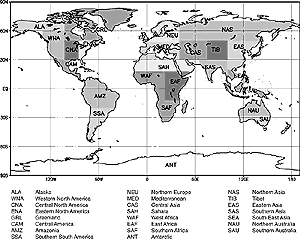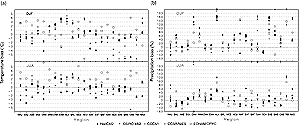10.3 Regional Attributes of AOGCMs
10.3.1 Simulations of Current Climate
10.3.1.1 Mean climate
Although current AOGCMs simulate well the observed global pattern of surface
temperature (see Chapter 8), at the regional scale substantial
biases are evident. To give an overview of the regional performance of current
models, results are presented of Giorgi and Francisco (2000b), who compared
model and observed seasonal mean temperature and precipitation averaged for
the regions indicated in Figure 10.1. The AOGCM experiments
they considered were a selection of those available through the IPCC Data Distribution
Centre (DDC) and included single simulations using the CSIRO Mk2, CCSR/NIES
and ECHAM/OPYC models, a three-member ensemble of CGCM1 simulations and a four-member
ensemble of HadCM2 simulations (see Table 9.1 for
further model details). Figure 10.2 shows the biases in
regionally averaged seasonal mean surface temperature and precipitation for
1961 to 1990 using as reference the gridded analysis of New et al. (1999). Nearly
all regional temperature biases are within the range of ±4°C. The
main exceptions to this are negative biases of more than 5°C in some models
over Asia in DJF. Precipitation biases are mostly between -40 and +80%, with
the exception of positive biases in DJF in excess of 100% over central America
(CAM), northern Africa (WAF and SAH), Alaska (ALA), and some parts of Asia (EAS,
SAS, TIB and NAS). The regional biases of Figure 10.2
are, in general terms, smaller than those of a similar analysis presented in
the SAR (see also Kittel et al., 1998) which, for example, showed regional temperature
biases as high as 10 to 15°C in some models and regions. Given that the
current analysis also includes many more regions, this difference in general
performance strongly suggests that simulation of surface climate at the sub-continental
scale is improved in current generation AOGCMs.

Figure 10.1: Regions used for the analysis presented in Figures
10.2 to 10.5 (from Giorgi and Francisco, 2000b).
|

Figure 10.2: Surface temperature biases (in °C) and precipitation
biases (% of observed) for 1961 to 1990 for experiments using the AOGCMs
of CSIRO Mk2, CCSR/NIES, ECHAM/OPYC, CGCM1 (a three-member ensemble) and
HadCM2 (a four-member ensemble) with historical forcing including sulphates
(further experimental details are in Table 9.1).
Regions are as indicated in Figure 10.1 and observations
are from New et al. (1999a,b). (a) surface air temperature, (b) precipitation
(from Giorgi and Francisco, 2000b). |
Current generation AOGCM simulations in which historical changes in climate
forcing over the 20th century are used enable simulated regional climatic trends
to be assessed against observations. This was done by Boer et al. (2000a) for
temperature and precipitation for the regions of southern Europe, North America,
Southeast Asia, Sahel and Australia (defined as in the SAR) using the CGCM1
model. Simulated and observed regional linear temperature trends agreed for
all regions, except the Sahel, when sulphate forcing was included. Little could
be said about agreement in observed and model precipitation trends as these
trends were weak over the period in both the model and the observations.
It should be stressed that assessments of model regional performance based
on area-averaging of AOGCM output over broad regularly-shaped regions should
not be assumed to apply to all areas within these regions. Many of the regions
considered contain a number of distinct climate regimes, and model performance
may vary considerably from regime to regime. For the purpose of assessing model
performance in a particular region, more detailed analysis is appropriate.
Where studies have examined spatial patterns within regions (e.g., Joubert
and Tyson, 1996; Labraga and Lopez, 1997; Lal et al., 1998a), reasonable correspondence
with observations was found, especially for temperature and mean sea level pressure
(MSLP). Most studies focus on seasonal mean conditions, but models can be analysed
to focus on simulation of specific climate features. For example, Arritt et
al. (2000) examined circulation and precipitation patterns associated with the
onset of the North American monsoon in simulations with the HadCM2 model, and
found this feature to be well simulated. Some studies have identified important
errors in current simulations of regional MSLP, such as the tendency for pressure
to be too low over Europe and too high north and south of this area (Machenhauer
et al., 1998). Such errors contribute significantly to local temperature and
precipitation biases both in the global climate model and in nested high-resolution
RCM simulations (Risbey and Stone, 1996; Machenhauer et al., 1998; Noguer et
al., 1998).
As would be expected, GCM simulations of current climate are often poor at
the local scale (e.g., Schubert, 1998). However, in areas without complex topography,
it is possible for the model results at individual grid points to compare well
with observations (Osborn et al., 1999).

